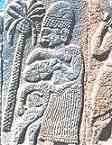 The Hittite fortress of Karatepe-Aslantas used to be within the province of Adana (135 kilometers / 84 miles), but in 1996 it passed to Kadirli district of Osmaniye province, approximately 25 kilometers (15 miles) from the center. It was founded in the 8th century BC by Azatiwatis, ruler of the plain of Adana as a frontier castle against the wild hordes lurking in the north. He named it Azatiwadaya. A caravan road leading from the southern plains up-to the Central Anatolian plateau, skirted it on the west, the Ceyhan river (antique Pyramos, now Aslantas dam lake) on the east. Two monumental T-shaped gate-houses flanked by high towers gave access to the citadel. An entrance passage between two towers led up to a double-leafed wooden gate, which swung on basalt pivot-stones, from there to two lateral chambers and further on into the citadel. In a holy precinct at the inner entrance of the southwest gate stood the monumental statue of the Storm-God on its double bull-suckle. The inner walls of the gate-houses were adorned with sculptures of lions and sphinxes, inscriptions and relieves, depicting cultural, mythological and daily-life scenes carved on blocks of basalt. A bilingual text in Phoenician and Hieroglyphic Luwian, the longest known texts in these languages, was inscribed on slabs of each gate with a third one in Phoenician on the Divine Statue, constituting the key for the final decipherment of the Hieroglyphs, being thus reminiscent of the famous Rosetta Stone.
The Hittite fortress of Karatepe-Aslantas used to be within the province of Adana (135 kilometers / 84 miles), but in 1996 it passed to Kadirli district of Osmaniye province, approximately 25 kilometers (15 miles) from the center. It was founded in the 8th century BC by Azatiwatis, ruler of the plain of Adana as a frontier castle against the wild hordes lurking in the north. He named it Azatiwadaya. A caravan road leading from the southern plains up-to the Central Anatolian plateau, skirted it on the west, the Ceyhan river (antique Pyramos, now Aslantas dam lake) on the east. Two monumental T-shaped gate-houses flanked by high towers gave access to the citadel. An entrance passage between two towers led up to a double-leafed wooden gate, which swung on basalt pivot-stones, from there to two lateral chambers and further on into the citadel. In a holy precinct at the inner entrance of the southwest gate stood the monumental statue of the Storm-God on its double bull-suckle. The inner walls of the gate-houses were adorned with sculptures of lions and sphinxes, inscriptions and relieves, depicting cultural, mythological and daily-life scenes carved on blocks of basalt. A bilingual text in Phoenician and Hieroglyphic Luwian, the longest known texts in these languages, was inscribed on slabs of each gate with a third one in Phoenician on the Divine Statue, constituting the key for the final decipherment of the Hieroglyphs, being thus reminiscent of the famous Rosetta Stone.
After the fall of the Hittite Empire, which ruled Central Anatolia in the 2nd millennium BC, due to the invasion of the so-called "Sea People" around 1200 BC small kingdoms such as those of Malatya, Sakcagözü, Maras, Kargamis, and Zincirli sprang up south of the Taurus mountain range. They were conquered and destroyed in the course of various Assyrian campaigns. The reign of Asatiwatas coincides with this period. His citadel was probably looted and burnt down to the ground by Salmanassar V around 720 BC or by Asarhaddon around 680 BC.
The site was discovered in 1946 by local shepherds, first excavations started by German archaeologist Helmuth Theodor Bossert and then continued by Turkish archaeologist Mrs. Halet Çambel after 1952. She played a key role in the decryption of Hittite hieroglyphics on site. Most of the artifacts in the open-air museum are original, not transfered to museums, except some small items.

